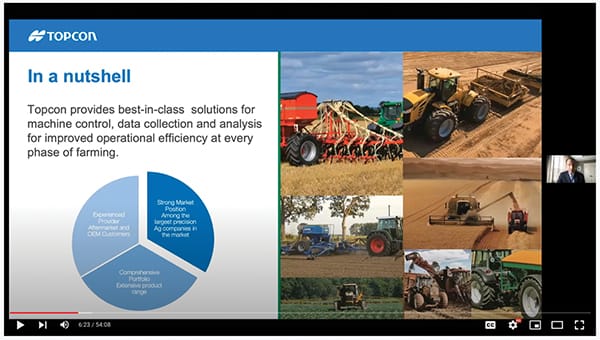Most references to the digital divide have to do with rural connectivity and how easy or difficult it is for farms to maintain internet access. However, Jared Ochs has a different type of digital divide on his mind.
“The digital divide we’re talking about here is transitioning from a legacy model when it comes to selling precision ag hardware, software and services into a new, more progressive model,” Ochs says.
Ochs is the IoT and (TAP) Topcon Agriculture Platform, Global Product Manager for Topcon Positioning Systems.
As dealerships move toward a modernized sales model, Ochs emphasizes the importance of caring for and meeting the needs of all customers, regardless of their technological background or interests.
“The thing we all love about this business is our customers,” he says. “We’re categorizing the customers into 2 categories. There’s the traditional majority — an old-school customer, like a grandfather or great-grandfather, where [decisions were made with] a handshake and a promise. Those customers are definitely still out there. We still do a lot of business with those customers. But our customers and their needs are changing. Their demands are changing. Their requirements and their service level agreements are changing. They expect a resolution in seconds or minutes vs. hours or days.
“We want to urge each of you to make sure the needs of both of these buyers are addressed in your offering. Have something that ticks that return-on-investment box right away for those analytical buyers, where some of those relationship buyers may see the longer trajectory or the bigger picture in the purchasing decision.”
Prioritize Effectiveness Over Hype
Ochs notes that it can be easy to get swept away by the excitement of a new technological tool or innovation and lose sight of ways in which that product will actually serve the needs of the dealership and its customers.
“In our industry — or with anything — there’s always someone who is an innovator, who’s willing to try that item before anybody else even considered it,” Ochs says “They’re early adopters. Then there are the laggards.”
It’s important to keep in mind something called the hype cycle, Ochs says. The hype cycle refers to the peak of excitement initially felt by consumers when a new product is revealed, as well as the subsequent disappointment.
“Unfortunately, every product can’t be perfect from generation one,” Ochs says. “There is a bit of a letdown. That typically overlaps with the early adopter phase. The satisfaction the customer receives may actually go down into what’s called the trough of disillusionment.”
Ochs says that hype cycle is on full display in the realm of artificial intelligence and the barrage of stories and information about AI that have recently flooded the media landscape. While people are repeatedly told that new AI systems will solve a lot of existing problems, he says it’s likely those products are simply being marketed well and customer satisfaction will decrease after the initial roll-out.
Ochs doesn’t want that to happen at ag dealerships, and he advises dealers to keep the hype cycle in mind when deciding how to introduce new products or technologies.
Work Together to Behave Proactively
It’s crucial, Ochs says, to embrace a paradigm shift from reactive to proactive strategies.
“It’s simply the nature of the dealership structure to be reactive,” he says. “We react to a quotation request by a customer. We react when products break or machines fail or bearings seize up. That will always be a component of agriculture. But we want to work through the scalability of a solely reactive model — there are only so many hours in the day and only so many people in the organization. Migrating toward a proactive model, or combining a proactive and reactive model, can serve a wider array of customers with a more comprehensive set of services.”
Ochs emphasizes the importance of including the entire organization in making the changes necessary for such a change — even if it seems impossible.

“Understand the value of the knowledge that you have in your heads, the value of the training that your organization and your OEMs have put into you and your staff. Be proud of the value of the knowledge...”
–Jared Ochs, Global Product Manager
“[Some dealers may hear me] say that you should include the entire organization in these planning and development opportunities and say to [themselves], ‘That will never work in our organization — we’re really siloed,’” Ochs says. “I want to push you to try to break through those barriers because it definitely is possible. You’ll see a real camaraderie come around the hardware and the technology because precision agriculture products are cool. They’re fun and exciting. Bringing other folks in the organization into that world to whatever degree they’re comfortable with will create an inclusive and positive environment.
“Engage the entire organization and make it a group effort.”
It can be overwhelming to decide where to begin, and Ochs encourages dealers to start simple. While many dealerships ask their original equipment manufacturer (OEM) what to do first, or look to regional competitors and mimic what they’re doing, he says that’s not the surest path to success.
“Evaluate what you’re already doing today, what your customers are commonly requesting help with, and start there,” Ochs says. “It’s a fairly traditional pitfall for most dealerships to complicate this activity [by following] a suggestion of the OEMs. A common example of this would be multitier support level contract — bronzes, silvers and golds. Those are fairly traditional approaches, but that may not be the best starting point for you and your organization.
“If it is, and it’s something you can effectively explain or sell to a customer, that’s half the battle. The other half is tracking what was delivered to the customer and that they’re satisfied.”
Don’t Sell Yourself (Or Your Resources) Short
According to Ochs, a common organizational fear is that adding in extra charges such as fees for support or a software update will lead to a decrease in customers. However, he says that while that fear is natural, it’s also unfounded.
“In my experience, and [what I’ve heard from] other folks who have successfully implemented some of these models, although there is a little bit of that, you gain much more than you lose — both from a customer satisfaction standpoint and a revenue standpoint,” Ochs says.
Ochs urges dealerships to charge for those small items, rather than giving away their time and knowledge. Otherwise, he says, dealers risk setting the expectation that those services will always be provided free of charge.
“A good example of this might be a copier repairman in your dealership,” Ochs says. “You probably have some fancy copier that is a high-dollar piece of equipment, but if there’s as much as a paper jam, they call someone to clear that. I guarantee your organization is going to receive a bill for that, and that’s just the copier. It’s not a combine. It’s not a sprayer. It’s not a precision multi-layer nutrient strip-till applicator that costs hundreds of dollars a pass to operate.
“So, understand the value of the knowledge that you have in your heads, the value of the training that your organization and your OEMs have put into you and your staff. Be proud of the value of the knowledge.”
Ochs acknowledges that some dealers may be hesitant to change a system that’s already working. However, he stresses that market variability can cause any dealership’s profits to decline.
“The markets are very cyclical — the commodity markets, the sales environment,” Ochs says. “Things are great when everything is really, really good, but things can be rough when sales are down and the market is in a recover position. Maybe your used equipment sales are still strong because they’re at a lower price point, but I would urge you to look at these revenue models for service offerings at low price points as well. It’ll help you cross those peaks of market volatility.”
Additionally, Ochs says, finding ways to add supplemental revenue to a dealership’s model enables that dealership to increase staff and consider adding a new department to deal with specific issues, such as data management or hardware services.
Increased Communication Creates New Revenue Opportunities
Because we live in a world that’s constantly connected, Ochs says it’s easier than ever to consistently communicate with customers and their equipment. He views that as a big benefit, as it means dealers can offer real-time software updates and other supports that weren’t available years ago.
“The ingredients are all there to put together a comprehensive package that delivers lots of value to your customer,” Ochs says.
Ochs suggests that dealerships explore package and subscription options for the hardware and technology components of farm equipment, specifically focusing on ways to be proactive during the months that the fields are covered with snow.
“Some ideas could be seasonal activities — you could develop packages or a la carte items centered around things in your area or region,” Ochs says. “Maybe that’s field preparation for rice production, maybe levy building, maybe things around harvesting or seeding or planting. Divide up the growth cycle from preparation and planning to seeding, et cetera — think through that.
“What’s really beneficial to customers is migrating away from just that one time where you had those services available to purchase.”
Although Ochs is eager for more dealerships to begin embracing a progressive sales model — one that relies more heavily on technological advancements — he acknowledges that it won’t always be easy.
“There are still problems to solve, he says. “There’s still a lot of things to work on. We’re migrating users’ data toward the cloud every day, but are our customers truly recognizing value from that cloud connection, or is it a more effective way to get pretty maps?”
Ultimately, Ochs says, it’s important to start small and build in opportunities for minor successes before moving toward big changes — and commitment is vital.
“If you are looking for ways to implement these strategies, keep them very simple,” he says. “Clearly communicate them to your customers and your staff, and get buy-in from all parts of the organization. Really be committed to whatever you decide and agree upon as an organization. Once that game plan is made, fully execute that plan in its entirety.”
Learn More Online
Want to hear more from Jared Ochs? View his webinar “Crossing the Digital Divide — Fostering Beneficial Customer Relationships with Data Management” to learn more about building effective and scalable revenue-based support and service models. During the webinar, Ochs also touches on supporting the changing farm risk management and crop insurance challenges, real-time remote support and fleet/machine health systems, and utilizing effective and open data transfer and processing systems across all brands. You can find the webinar replay here.







